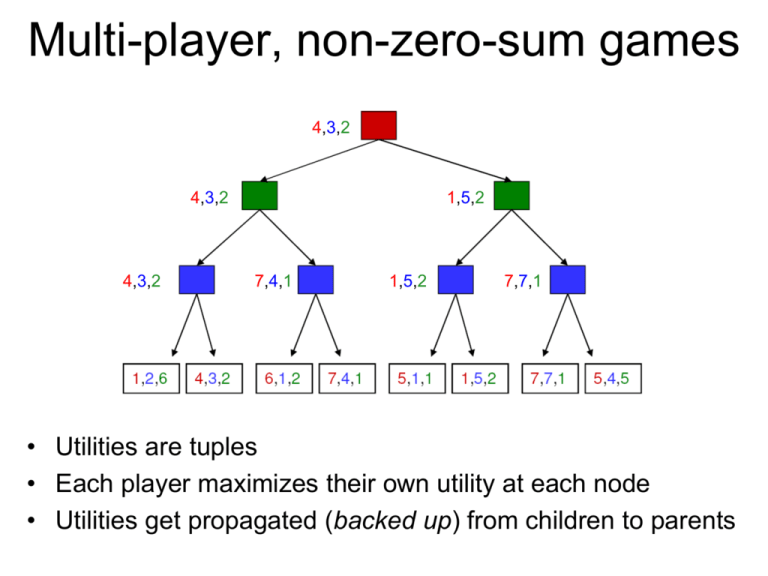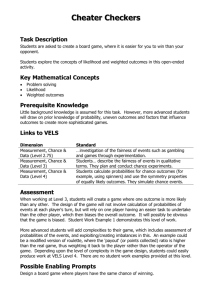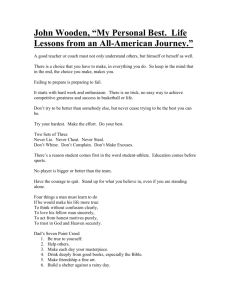PPT
advertisement

Multi-player, non-zero-sum games 4,3,2 4,3,2 4,3,2 1,5,2 7,4,1 1,5,2 7,7,1 • Utilities are tuples • Each player maximizes their own utility at each node • Utilities get propagated (backed up) from children to parents Game theory • Game theory deals with systems of interacting agents where the outcome for an agent depends on the actions of all the other agents – Applied in sociology, politics, economics, biology, and, of course, AI • Agent design: determining the best strategy for a rational agent in a given game • Mechanism design: how to set the rules of the game to ensure a desirable outcome Simultaneous single-move games • Players must choose their actions at the same time, without knowing what the others will do – Form of partial observability Normal form representation: Player 1 Player 2 0,0 1,-1 -1,1 -1,1 0,0 1,-1 1,-1 -1,1 0,0 Payoff matrix (row player’s utility is listed first) Note: this is a zero-sum game Prisoner’s dilemma • Two criminals have been arrested and the police visit them separately • If one player testifies against the other and the other refuses, the one who testified goes free and the one who refused gets a 10-year sentence • If both players testify against each other, they each get a 5-year sentence • If both refuse to testify, they each get a 1-year sentence Alice: Testify Alice: Refuse Bob: Testify -5,-5 -10,0 Bob: Refuse 0,-10 -1,-1 Prisoner’s dilemma • Alice’s reasoning: – Suppose Bob testifies. Then I get 5 years if I testify and 10 years if I refuse. So I should testify. – Suppose Bob refuses. Then I go free if I testify, and get 1 year if I refuse. So I should testify. • Dominant strategy: A strategy whose outcome is better for the player regardless of the strategy chosen by the other player Alice: Testify Alice: Refuse Bob: Testify -5,-5 -10,0 Bob: Refuse 0,-10 -1,-1 Prisoner’s dilemma • Nash equilibrium: A pair of strategies such that no player can get a bigger payoff by switching strategies, provided the other player sticks with the same strategy – (Testify, testify) is a dominant strategy equilibrium • Pareto optimal outcome: It is impossible to make one of the players better off without making another one worse off • In a non-zero-sum game, a Nash equilibrium is not necessarily Pareto optimal! Alice: Testify Alice: Refuse Bob: Testify -5,-5 -10,0 Bob: Refuse 0,-10 -1,-1 Prisoner’s dilemma in real life • Price war • Arms race • Steroid use Cooperate Defect Cooperate Win – win Win big – lose big Defect Lose big – win big Lose – lose http://en.wikipedia.org/wiki/Prisoner’s_dilemma Is there any reasonable way to get a better answer? • Superrationality (Douglas Hofstadter) – Assume that the answer to a symmetric problem will be the same for both players – Maximize the payoff to each player while considering only identical strategies – Not a conventional model in game theory Stag hunt Hunter 1: Hunter 1: Stag Hare Hunter 2: Stag 2,2 1,0 Hunter 2: Hare 0,1 1,1 • Is there a dominant strategy for either player? • Is there a Nash equilibrium? – (Stag, stag) and (hare, hare) • Model for cooperative activity Prisoner’s dilemma vs. stag hunt Stag hunt Prisoner’ dilemma Cooperate Defect Cooperate Win – win Win big – lose big Defect Lose big – win big Lose – lose Players can gain by defecting unilaterally Cooperate Defect Cooperate Win big – win big Win – lose Defect Lose – win Win – win Players lose by defecting unilaterally Coordination game (Battle of the sexes) Wife: Ballet Wife: Football Husband: Ballet 3, 2 0, 0 Husband: Football 0, 0 or 2, 3 Wife: Ballet Wife: Football Husband: Ballet 3, 2 0, 0 Husband: Football 1, 1 2, 3 • Is there a dominant strategy? • Is there a Nash equilibrium? – (Ballet, ballet) or (football, football) • How do we figure out which equilibrium to choose? Game of Chicken Player 1 S Player 2 Straight Chicken Chicken Straight C S -10, -10 -1, 1 C 0, 0 1, -1 • Is there a dominant strategy for either player? • Is there a Nash equilibrium? (Straight, chicken) or (chicken, straight) • Anti-coordination game: it is mutually beneficial for the two players to choose different strategies – Model of escalated conflict in humans and animals (hawk-dove game) • How are the players to decide what to do? – Pre-commitment or threats – Different roles: the “hawk” is the territory owner and the “dove” is the intruder, or vice versa http://en.wikipedia.org/wiki/Game_of_chicken







